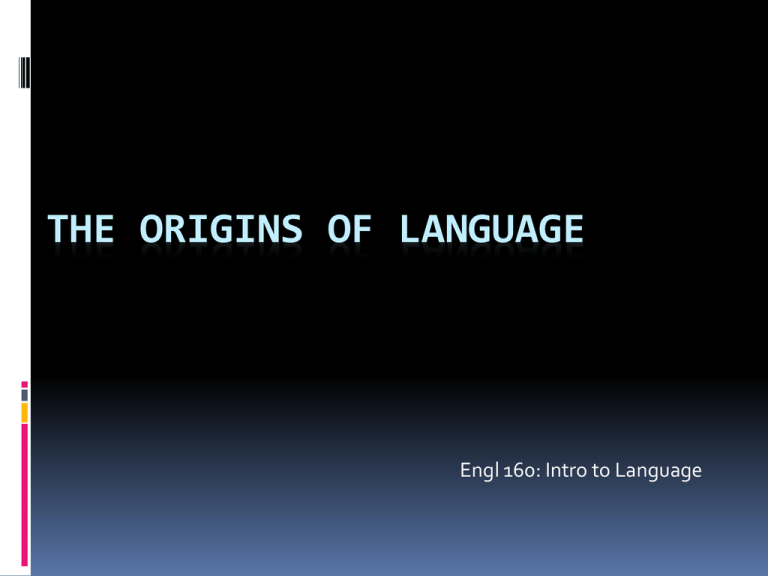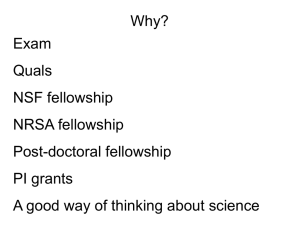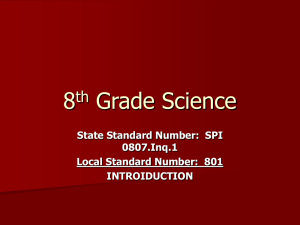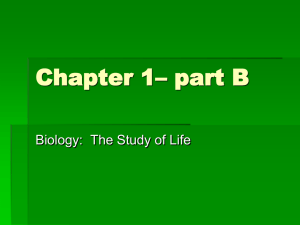File - introduction to language
advertisement

THE ORIGINS OF LANGUAGE Engl 160: Intro to Language Overview •Where did language come from? •Did all humans always speak? • When did language evolve? •Why? •Was there more than one original language? •What is the Language Acquisition Device? •Did it evolve as humans evolved? The Theories •Divine source • Natural sound source •The natural sound source •The social interaction source •The physical adaptation source •The tool making source •The genetic source Divine Creation of Language Many societies throughout history believed that language is a gift of the gods to humans: “Adam gave names to all living creatures.” Humans were created from the start with an innate capacity to use language. This capacity is complex – there are NO PRIMITIVE LANGUAGES!! Nor have there ever been – even among the most remote tribes today or of stone-age huntergatherers! Psammetichus and the babies raised by goats. Ba-ba? King James of Scotland and the Hebrewspeaking babies. But empirical evidence from children raised without exposure to language shows that these children grow up with no language at all. Exposure to language before the age of 7 is critical to language development. This is called The Critical Period for language acquisition (natural sound source) “Ding-Dong” – humans named objects, actions and phenomena after a recognizable sound associated with it. The first human words were a type of ICON, a sign whose form is an exact image of its meaning: Boom = explosion (English) Tun-tun = heart (Chinook Indian) Ai-ai = knife (Basque, literally “ouch-ouch”) Cont.. “bow-wow” – human vocabulary developed from animal noises, e.g., Moo, hiss, quack, meow, etc. Onomatopoeia: lit. “name-sound” the imitation of a sound in naming. Drawbacks: Limited part of vocabulary. Different from language to language: Russian ba-bakh = bang; bukh = thud Cont…. “pooh-pooh” Hypothesis: humans’ first words were derived from spontaneous expressions of dislike, hunger, pain, or pleasure. Ha-ha-ha, wah-wah Problems: Very small part of any language. Differ from language to language: English ouch; Russian oi; Cherokee eee, Basque ai Made with intake of breath, which is the opposite of normal talking. Renditions of animal sounds differ considerably from language to language, even though the animal makes essentially the same sound: Dog: bow-wow; Chinese wu-wu; Jap. wan-wan; Russian gaf-gaf or tyaff-tyaff Cat: meow; Russian myaoo; Chinese mao; Japanese nya-nya Rooster: cocka-doodle-do; Japanese kokekoko; Greek kikuriku, kikikiriki PROBLEM: Where do names for natural noiseless concepts come from: rock, sun, sky, love???? “ta-ta” Hypothesis. Charles Darwin theorized that speech may have developed as a sort of mouth pantomime – the organs of speech were used to imitate the gestures of the hand. The first words were lip icons of hand gestures. Same problem as for onomatopoeia – different gestures in different cultures: crossing fingers for good luck in English versus Russian “fig” gesture; nodding “no” in Greek versus “yes” in English Even Darwin himself thought this was a little implausible. Necessity Hypotheses “Necessity is the mother of invention” Warning Hypothesis. Language evolved from the warning signals used by animals. Perhaps language started with a warning sound to others, that signified “HELP!” or “RUN!” to alert other members to the approach of a lumbering hairy mammoth or hungry saber-tooth tiger. Other first words could have been hunting instructions. Necessity Hypotheses “yo-he-ho” Hypothesis: Language developed on the basis of human cooperation. The earliest language was chanting to stimulate collective effort, like moving a great stone to block off a cave entrance from roving carnivores, or repeating a war phrase over and over to inflame the fighting spirit. Poetry and song came to us this way – and we still have some “yo-he-ho” ones: the Volga Boat Song, Military drill chanting, the Seven Dwarves working song! Necessity Hypotheses The “Lying” Hypothesis: Sturtevant argued that since all our real intentions or emotions get involuntarily expressed by gesture, look, or sound, voluntary communication must have been invented in order to lie or deceive. He believed that the need to deceive and lie – to use language in contrast to reality for selfish ends – was the social prompting that got language started. Seems pretty far-fetched. The Real Reason For Language Other Sources of Language Physical Adaptation. Other primates, such as gorillas, do not have the same physical characteristics which make speech possible. upright teeth in humans (fricative sounds) Intricate lip muscles on humans Smaller, thicker more muscular tongue Humans can close off the nose to create more air pressure for sound in the mouth cavity. Other Sources of Language The human larynx, or “voice box,” which contains the vocal cords, is in a lower position in humans than in primates, creating a longer cavity called the pharynx. The pharynx is like a big echo chamber above the vocal cords for volume and clarity of sound. Unfortunate outcome: we can now choke on food. Monkeys can both breathe and drink or eat at the same time – we can’t. So can babies until their larynx drops as they mature. Other Sources of Language The tool-making source: As early humans’ hands became occupied with tool use, they were less able to use hand gestures, so speech became a necessity Preferential right-handedness Lateralized brain: each hemisphere has its own functions Speech and tool-making abilities are very close to one another in the left hemisphere Other Sources of Language The Genetic Source: a crucial genetic mutation arose which gave humans the unique ability to produce and understand language. This means that language is Innate Hard-wired like in a computer Pre-programmed Universal in form The innateness hypothesis states that language is endemic to all humans. But only to humans? We will explore this next week. Hypotheses Regarding Language Diversity • Was there one or more than one original language? •Was there one or more than one “invention” of language? •There are approximately 6,300 languages spoken on earth now, and an even greater number spoken in the past Discussion Questions What is the basic idea behind the bow-wow theory? Why are interjections like “ouch” considered to be an unlikely source of language origin? Where is the pharynx and how did it become an important part of human sound production? What happened at the Tower of Babel, and why is it used in explaining language origins? What is the connection between the innateness hypothesis and the idea of a Universal Grammar? Why do you think that young deaf children who become fluent in sign language would be cited as a support of the innateness hypothesis? Discussion Questions What is the connection between language, toolusing, and right-handedness? Why is it difficult to believe Psammetichus that Phrygian must have been the first language? What is monogenesis and how does it explain the development of languages? What theory of language diversity would explain having different families of languages? Discussion Questions Is there a connection between the Heimlich maneuver and the development of human speech? What are the arguments for and against a teleological explanation of the origins of language? Homework Read Chapter 2, Animals and Human Language, including study questions. References Yule, George. 2010. The Study of Language. 4th Edition. Vajda, Edward. Undated Manuscript. The Origin of Language. Fromkin, et. al. 2009. An Introduction to Language.











